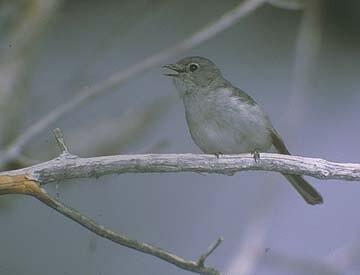Gray Vireo

Detailed Description
The gray vireo inhabits some of the hottest, most arid regions of the southwestern United States. It is a short-distance migrant and withdraws completely from most of its breeding range in winter. It prefers mixed juniper, pinyon, and oak scrub associations, chaparral in hot, arid mountains, and high plains scrubland. It eats a variety of arthropods, including large grasshoppers, cicadas, and caterpillars, which it gleans from the leaves, twigs, branches and trunks of small trees or twigs and branches of shrubby vegetation foliage. Gray vireo nests are often constructed on west- or north-facing tree forks. The nesting pair alternate brooding, which is continuous from hatching of first nestling and diminishes after the 6th day. Eggs are vulnerable to exposure to sun, and both adults have been observed shading nestlings. This species is on the 2007 (most recent) WatchList for United States Birds and the USFWS Federal list of birds of conservation concern due to its rarity.
Sources/Usage
Public Domain.

